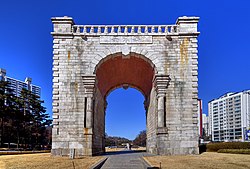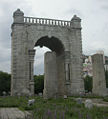Independence Gate
| Independence Gate (Dongnimmun Arch) | |
|---|---|
| Native name 독립문 (Korean) | |
 Front side of the Independence Gate in Seoul, South Korea | |
| Type | Memorial Arch |
| Location | 941, Hyeonjeo-dong, Seodaemun-gu, Seoul |
| Coordinates | 37°34′21″N 126°57′34″E / 37.5724101°N 126.9595249°E |
| Area | 2,715.8 m2 |
| Built | January 1898 |
| Architect | Sim Ŭi-sŏk[1] |
| Architectural style(s) | Triumphal arch |
| Governing body | Seodaemun District |
| Owner | Government of South Korea |
| Official name | Dongnimmun Arch |
| Designated | 21 January 1963 |
| Reference no. | 32 |
| Independence Gate | |
| Hangul | 독립문 |
|---|---|
| Hanja | 獨立門 |
| Revised Romanization | Dongnimmun |
| McCune–Reischauer | Tongnimmun |
Independence Gate (Korean: 독립문; Hanja: 獨立門) or Dongnimmun is a memorial gate in Seoul, South Korea. It was built in January 1898. Its construction was planned by Soh Jaipil, as a symbol of Korea's commitment to independence. It was designated as a Historic Site of South Korea in 1963, and relocated 70 metres (230 ft) northwest from the original location in 1979 for preservation.[2]
Dongnimmun measures 14.28 meters in height and 11.48 meters in width, and is made of approximately 1,850 pieces of granite.[3]
History
[edit]Background
[edit]In early 1895, the Government of Joseon abandoned its long-standing diplomatic policy of sadae. Under sadae, Joseon was a tributary state of Qing China. To celebrate this change, the Government of Joseon demolished Yeongeunmun in February 1895, which they had built in 16th century as a symbolic gate for welcoming Chinese diplomats to the country.[4] On April 17, 1895, the Joseon Government was formally released from China's sphere of influence with the conclusion of the Treaty of Shimonoseki between the Empire of Japan and the Qing dynasty at the end of the First Sino-Japanese War.[3][5][6]
Philip Jaisohn proposed the building a new gate near the former site of Yeongeunmun's ruins to symbolize the country's desire for freedom. This plan was approved by King Gojong, and the gate was named "Independence Gate".[5][3][6]
Plan for construction
[edit]To support construction of the gate, Soh created the Independence Club and published Korea's first modern newspaper named Tongnip sinmun. Regular citizens of Joseon donated to the construction of the gate via a public campaign run by the newspaper.[7] Soh wrote the following in the English edition of that newspaper:
The croakers may croak and the pessimists may growl and the independence of Korea may be treated as a joke by those who can see nothing but the fact that His Majesty is still enjoying the hospitality of the Russian legation but they all argue from their fears and not from either present facts or future probabilities. Today we rejoice in the fact that the King has decided to erect upon the ruins of the arch outside the West Gate, a new one to be entitled Independence Arch. 독립문. We do not know as its inscription will be written in on-mun but we wish it might. For centuries the arch stood there as a constant insult to the autonomy of Korea, an autonomy which China always hastened to assert when called upon to stand responsible for any tremble in the peninsula but which site always denied when it was safe to do so. She denied it once too many times and now her "suzerainty" is where the old arch is, namely op-so. And now an arch is to be raised on the same spot to stand forever as a negation of Manchu dominance to show that Korea is once and for all cut off from the blighting influence of Chinese patronage; cut off, we hope, also from the system of fraud, corruption and trickery which today makes that most populous empire the laughing-stock of the world. This arch means independence not from China alone but from Japan from Russia and from all European powers. …
— Soh Jaipil, Editorial, The Independent, June 20, 1895[8]
Construction and relocation
[edit]The design of Independence Gate was inspired by the design of the Arc de Triomphe in Paris. An unknown Swiss architect working for the German legation in Joseon created the blueprint for its construction.[7] Its construction began in 1896, and finished in January 1898. The construction process was overseen by Korean engineer named Sim Ŭi-sŏk.[1]
Subsequent history
[edit]The Government of South Korea designated it as a historic site of South Korea in 1963. The gate was initially located north of the ruins of Yeongeunmun, but was relocated 70 meters northwest from its original place with Plinths of Yeongeunmun Gate, Seoul, due to construction of a modern city road.[6][2] It is now located in Seodaemun Independence Park, where Dongnimmun is located, is easily accessed from Exit 4 or 5 of Dongnimmun Station on Seoul Subway Line 3.
Gallery
[edit]-
An editorial in Tongnip sinmun promoting fundraising for construction of Dongnimmun, July 4, 1896
-
An image of the invitation to the groundbreaking ceremony for the Independence Gate in November 21, 1896
-
Scene of Dongnimmun looking down the Plinths of Yeongeunmun Gate in 1904
-
The Chinese People's Volunteer Army storming through Independence Gate during the Third Battle of Seoul, January 1951
-
View of Dongnimmun from northern side in 1955 before relocation
-
Dongnimmun and Plinths of Yeongeunmun Gate, Seoul after relocation
-
Letters of '독립문' and Taegukgi is carved on arch via Vertical writing. Below sign of flower is symbol of House of Yi
See also
[edit]References
[edit]- ^ a b 독립문(獨立門). nrich.go.kr (in Korean). National Research Institute of Cultural Heritage. Retrieved August 1, 2022.
- ^ a b "Dongnimmun Arch, Seoul". Cultural Heritage Administration. Retrieved August 1, 2022.
- ^ a b c Pratt, Keith (2007). Everlasting Flower: A History of Korea. London: Reaktion Books. pp. 188–189. ISBN 978-1-86189-335-2.
- ^ Kong Chan, Robert (2018). Korea-China Relations in History and Contemporary Implications. Palgrave Macmillan Cham. p. 173. doi:10.1007/978-3-319-62265-1. ISBN 978-3-319-62265-1.
- ^ a b "History of Korea > The Establishment of Independence Gate (Dongnipmun)". National Institute of Korean History. Retrieved August 1, 2022.
- ^ a b c Nam, Hyun-woo (2015-11-01). "Dongnimmun: gate reflects Korea's strong desire for independence". The Korea Times. Retrieved 2023-06-28.
- ^ a b Kim, Hyung-eun (2009-06-07). "Gate of independence, spirit of triumph". Korea JoongAng Daily. Retrieved August 1, 2022.
- ^ Soh, Jaipil (1895-06-20). "The Croakers May Croak and the Pessimists May Growl and the Independence of Korea May …". Korean Newspaper Archive. The independent (digitally archived by National Library of Korea Newspaper archive). Retrieved 2022-07-25.
External links
[edit]- Historic Sites of South Korea
- 1890s establishments in Korea
- Buildings and structures in the Korean Empire
- Philip Jaisohn
- Triumphal arches
- Gates in South Korea
- Buildings and structures in Seodaemun District
- Buildings and structures completed in 1898
- Relocated buildings and structures
- History of Seoul
- Historic buildings and structures in Seoul








